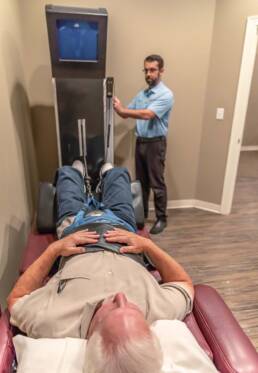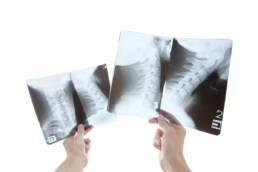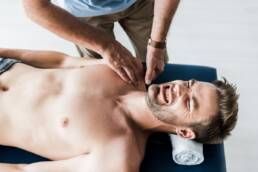The last thing you feel like doing when you have a neck injury is moving more than is absolutely necessary. Even looking from one side to another can cause twinges of pain in both the affected area and to radiate throughout your upper body, depending on the severity of your whiplash injury.
Fortunately, you don’t just have to settle for the pain and stiffness. Rather, with the appropriate effort on your end, you can accelerate your healing and reduce the amount of discomfort you feel. Discover what you need to know about whiplash and then try these seven stretches and exercises.
Caution With Stretching and Exercise After Whiplash
While it’s important to get moving after a soft tissue injury like whiplash, it’s equally important to proceed with caution. There are four grades of whiplash severity, with increasingly disruptive symptoms. The grade of your injury will affect what is safe for you to do, and the extent to which it’s safe to push yourself. Review the severity of your injury with your doctor, and then make a plan for how to safely proceed with these stretches and exercises.
Whiplash Injury Grades
Grade 1 – This is the easiest grade to heal from and where you can push yourself the most. With Grade 1 whiplash, you’ll likely have some pain when moving your neck, some tenderness around the injured area, and some restricted movement.
Grade 2 – This progresses on the pain scale, with it fluctuating depending on how you move your neck. The pain may also radiate into your back, shoulders, face, and head, along with causing muscle spasms, swelling, and sensitivity around the injured area.
Grade 3 – Your symptoms will go beyond pain and discomfort and starts presenting neurological symptoms. This may include numbness, muscle weakness, vision problems, dizziness, and tingling or burning in the neck, shoulders, and upper arms.
Grade 4 – This final grade has a higher intensity of the Grade 3 symptoms along with a fracture or dislocation. You may also experience ringing in your ears, irritability, fatigue, nausea, difficulty swallowing, and pain in your extremities. This final grade constitutes a medical emergency and is worth calling an ambulance to transport you for immediate evaluation and treatment.
Stretches and Exercises You Can Do At Home
All of these exercises and stretches are easy to learn and perform. In fact, most of them you can do while sitting at home, in a parked car, at the office, or even sitting outside. Review all of these with your chiropractor to determine which are best to pair with your current chiropractic treatment.
Hearing a crunching sound or feeling a crunching sensation while doing these indicate something a structural misalignment in your neck. Be sure to tell your chiropractor so they can evaluate and perform the necessary adjustments.
1. Chin Tucks
This is a simple stretch that takes just a few minutes but is incredibly helpful following a whiplash injury. Chin tucks stretch the muscles in the cervical spine, which is the top part of the neck, just below the base of the skull.
Sit with your head squarely over your shoulders and your chin slightly tilted upward. Then do the following:
- Move your chin toward your chest.
- Stop when you feel a comfortable stretch from your neck to the base of your skull.
- Hold for about 5 seconds.
- Rotate your head back up until your chin points up slightly.
- Repeat about 10 times.
2. Side to Side Rotation
Moving your head from side to side will help alleviate tightness and improve the mobility in your neck. Be careful while doing this stretch to move slowly and with intention to prevent further aggravating the area and increasing inflammation.
Sit with your head squarely over your shoulders and look straight ahead. Then do the following:
- Slowly rotate your head to the left by moving your chin toward your left shoulder.
- Stop when you feel a comfortable stretch on the side of your neck that you’re turning toward.Note: use your right hand to gently push your chin to help get a deeper stretch.
- Once you feel a comfortable stretch, hold for about 20 seconds.
- Release and now turn to the right and repeat the process.
- Do the stretch three to five times on each side.
3. Isometrics
Isometric exercises are exercises that tighten a specific group of muscles without moving the affected joints. Therefore, neck isometrics tighten the muscles in your neck without actually moving your cervical joints. This helps maintain strength in your neck, and according to some studies, they also provide some pain relief.
There are four specific isometric exercises to practice while recovering from whiplash. Start by sitting with your head squarely above your shoulders, then do the following:
- Put your left hand and your left temple.
- Apply pressure while attempting to turn your head to the left. Apply increasing pressure until you feel your neck muscles tighten.
- Hold for 3 to 5 seconds.
- Repeat this process on the right side.
- Now put both hands on your forehead and repeat the process.
- Finally, put both hands behind your head and repeat the process.
- Repeat this exercise 10 times per day.
4. Side Bends
You can decrease tightness and increase your mobility by stretching the sides of your neck. Start with sitting straight with your head squarely above your shoulders. Now do the following:
- Tilt your head to the left, lowering your left ear toward your shoulder.
- Use the hand on the same side that you’re bending toward to gently pull your head to deepen the stretch if needed.
- Once you feel a comfortable stretch, hold for 20 seconds.
- Repeat the process to the right side.
- Complete three to five times per side.
5. Scapular Stabilization
This stretch helps relieve neck pain whenever your neck gets tight and sore. Start by sitting straight up with your back straight, not resting against a chair back. Now do the following:
- Let your hands hang down and relax your shoulders.
- Move your shoulders backward, pulling your shoulder blades back. This should push your chest forward.
- Now pull your shoulder blades down by pulling your elbows slightly forward.
- Hold for 10 seconds.
- Repeat this five times and do it twice a day.
6. Levator Scapular Stretch
The levator scapulae muscle connects the scapula bone to the top of the neck. This muscle can create a big knot in the top of your back. Start by sitting on a bench or chair with your back straight. Then do the following:
- Hold the bottom of the seat with one hand.
- Turn your chin toward your left armpit until you feel a comfortable stretch on the right side of your neck.
- Use your right hand to deepen the stretch if needed.
- Hold for 20 seconds and then release.
- Repeat the process toward the left.
- Complete three repetitions, and do it twice a day.
7. Gentle Walks
Walking helps increase blood flow to injured tissues during the healing process. This is not a strenuous walk for cardiovascular exercise. Rather, it’s to keep the joints moving and increase circulation. Start with a gentle 10-minute walk a few times each day. Even walking around your office or home is enough to keep things moving properly and encourage healing.
Get additional help recovering from your Conroe area whiplash injury by scheduling a complimentary consultation with the expert team at Freedom Chiropractic by calling (936) 756-3747 today.

Ready for a complimentary consultation? Get in touch today!
Much like an engineer, we focus on setting up your body to do the activities that you want to do most. An engineer would make sure a bridge could accommodate Houston traffic, and we will make sure your body can accommodate your favorite sport, family activity, or your next adventure.
Like this article? Spread the word!
Related Posts
May 15, 2025
Comprehensive Auto Injury Treatment in Montgomery, Texas: Chiropractic Care, Spinal Decompression, and More
Seeking effective auto injury treatment in Montgomery, Texas? Explore chiropractic care,…
May 15, 2025
The Importance of Auto Injury Chiropractic Care in Conroe, TX: How a Car Accident Chiropractor Can Help You Recover
If you've been in a car accident, injury chiropractic care can help with pain relief and…
February 15, 2025
Auto Injury Chiropractic Care at Freedom Chiropractic in Conroe, Texas
Been in an auto accident in Conroe, TX? Freedom Chiropractic offers expert chiropractic…




